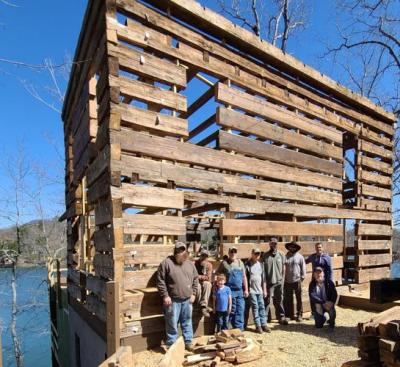Russell's Fort Remains Steeped in History
By DAVID R. DiOrio Special to The Daily Courier, Mar 22, 2022
LAKE LURE — A local historical landmark has found a new home in Lake Lure. Russell Fort, previously located east of town along U.S. Highway 64/74 on the Rocky Broad River, was disassembled and restored by the team from the hit TV series “Barnwood Builders” and is being reassembled near the shore of the lake on Gentle Winds Lane.
James Sciandra of Lake Lure, with the help of local craftsman Harold Harper, reached out to Barnwood Builders to preserve this important symbol of local history. He plans to resurrect the Fort using the original timbers to preserve the history for future generations. Two shows will feature the move and will be shown on the Magnolia Channel later this year.
The history of the Fort is a great American story about a patriotic and pioneering family that settled on the western most frontier of North Carolina along an established border with the Cherokee Nation. Just before the American Revolution an Irish immigrant, George Russell Sr., married a local widow, Mary Whiteside, and settled along the banks of the Rocky Broad just South of Hickory Nut Gorge where Lake Lure Marine stands today. In 1767, the Royal Governor of North Carolina, William Tryon, negotiated a treaty with the Cherokee to reduce tensions by promising to cease westward settlement across an agreed borderline that extended from South Carolina to Virginia.
George Russell Sr., a founding member of the Tryon County (later Rutherford County) Committee of Safety, arranged for the construction of the Rocky Broad Station, a militia supply and mustering point to protect local settlers near the border line. The Station served as a home, center for trade, and a rallying point for protection. In 1775, additional buildings were constructed on the high ground (Russell’s Fort) to guard against an emerging Loyalist and persistent Cherokee threat; allies to the British.
During the American Revolution (1780), British Maj. Patrick Ferguson, a promising young officer and trusted aide to Lord Cornwallis (the Commanding General of British Forces in the South) was ordered to scout Western North Carolina to recruit and train a Loyalist cavalry unit and subdue the Patriot militias. The British tactics were ruthless. The British threatened families, coerced young men to join at the “tip of a bayonet”, foraged scarce food reserves, and confiscated family valuables. In September 1780, Ferguson established a short-term base camp at Gilbert Town, just north of Rutherfordton. According to family historical archives and confirmed in soldier diaries; the area, including Russell Station was raided by Ferguson’s men.
After a skirmish on September 12, 1780 on nearby Cane Creek, the British encamped for 10 days within a few miles of the station. The Russell family received advanced warning and fled, but had enough time to hide the family silver and coveted linens in a “hogshead” or small barrel. Ferguson’s men plundered the station and confiscated valuables including the silver. The raid is documented as the westernmost British raid during the war.
Within days of the raid, Ferguson’s loyalist cavalry rode to Charlotte to join with the main British Army. On October 7, 1780, his legion was cornered at Kings Mountain by Patriot militia units from across the region (called Overmountain Men) and was decimated. Maj. Ferguson was killed and several Loyalist prisoners were marched back to Gilbert Town, tried, and hung for treason.
The raid marked the start of a series of engagements that significantly weakened the British Army through attrition and restricted their movement in the back country. Lord General Cornwallis was forced to vacate the Carolinas in 1781 and deployed into Virginia where he was decisively defeated at the Battle of Yorktown in October 1781. The raid at Russell Fort epitomized the British failure to win the “hearts and minds” of Carolina settlers that ultimately led to their defeat and the birth of our nation.
George Russell returned to Russell Station after the raid. He was an avid bear hunter and unfortunately ventured West into Cherokee hunting grounds where he was killed in 1782. His stepson, John Whiteside Jr., assumed duties as the family patriarch. As a venerated Patriot leader in the Battle of Kings Mountain, the new government offered him possession of property that was “marked within one day’s ride.” John took advantage of that offer, and much of Hickory Nut Gorge as far as Rumbling Bald was settled and farmed by the Whiteside family descendants later to be known as Whiteside Valley.
For the next 200 years, the original hand-hewn log structure was occupied by the Whitesides. Around 1893, during the post-Civil War “Reconstruction Period”, the Rev. Zachary Taylor Whiteside built a plantation farmhouse around the original logs to elevate the property to a higher level of prominence.
The farmhouse exterior protected much of the log framework, enabling the restoration effort today. The farm was affectionately known as the “Pumpkin Center of the South” during the 1950s, 60s, and 70s, where thousands of pumpkins were prominently displayed and children played in the extensive pumpkin fields.
The patriotic Whitesides, many who followed tradition and served in the military, stood proud as they watched the filming of their ancestral home being preserved. Russell Fort continues to stand tall as a symbol of protection for our nation at the time of its inception to a new mission of standing watch on Lake Lure, a timeless icon of American freedom and North Carolina heritage.


